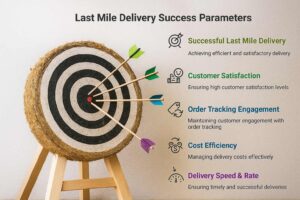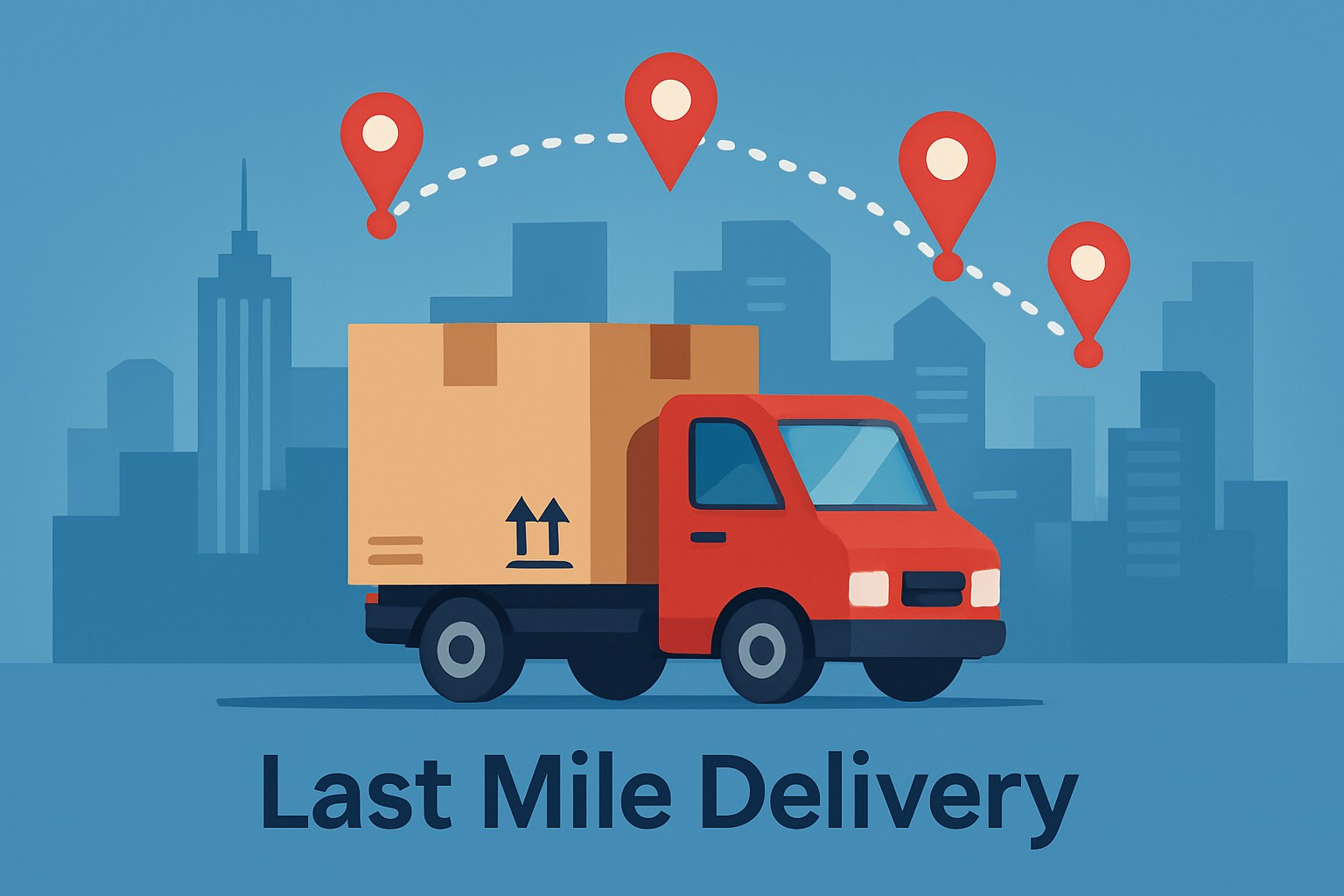Quick Links
ToggleLet’s talk about the most important part of the delivery process. It’s not when a product leaves the warehouse, but when it reaches your customer’s doorstep. That final stretch is called last-mile delivery. It may sound simple, but it’s often the most expensive and time-consuming part of the whole supply chain. Whether you run a small business or manage large-scale logistics, how you handle last-mile delivery can shape your customer’s experience. In this blog, we’ll take a closer look at what last-mile delivery means, why it matters, and how you can make it better.
What is Last Mile Delivery?
Last-mile delivery is the final and most important part of the delivery process. It’s when a package travels from the local warehouse or delivery hub to your doorstep or a retail store. This step plays a big role in how fast and smooth your delivery experience feels.
In India, where online shopping, food delivery, and retail are growing fast, last-mile delivery has become a key focus for businesses. Everyone wants their orders delivered quickly, and companies are working hard to meet those expectations. However, it’s also the most expensive part of the entire delivery chain, so getting it right matters for both customer satisfaction and business costs.
How Does Last Mile Delivery Work?
Here’s how last-mile delivery usually works:
- Step 1: Order Processing: First, the products are packed and labelled. Everything is checked to make sure it’s ready to be shipped.
- Step 2: Local Sorting Hub: Then, the packed items are sent to a nearby sorting center. Here, the products are grouped and organized based on where they need to go.
- Step 3: Route Optimisation: Smart software comes into play at this stage. It finds the best possible routes for delivery, helping save time and fuel.
- Step 4: Final Delivery: Finally, the delivery agent picks up the items and takes them straight to the customer’s doorstep. This is the last and most important step of the entire process.
Why is Last-Mile Delivery So Challenging?
Let’s get to the big question. Why is last-mile delivery often called the most complicated and expensive part of the logistics chain? There are multiple reasons behind it, and here’s a closer look at them:
- Cost Pressure: Last-mile delivery doesn’t come cheap. Fuel prices, driver wages, vehicle maintenance, and other day-to-day expenses can quickly eat into a business’s profit margins.
- Traffic and Road Issues: Heavy traffic in cities and poor road conditions can slow things down a lot. These delays are frustrating for both businesses and customers.
- Address Problems: Incomplete or incorrect addresses lead to wasted trips, delayed deliveries, and extra costs. Fixing these issues takes time and effort.
- Customer Availability: Sometimes, the customer just isn’t home. Missed deliveries mean rescheduling, which adds to the time, fuel, and manpower required.
- Unexpected Delays: Weather, traffic, or sudden issues in the supply chain can throw off the delivery schedule. One delay can trigger a chain reaction, leading to disappointed customers and financial setbacks.
- Handling Big or Fragile Items: Oversized or delicate parcels often need special packaging and careful handling. This slows down operations and adds more complexity.
- Not Enough Delivery Staff: During busy times like holidays or sales, the demand for delivery drivers often outweighs the supply. This can cause late deliveries and lower customer satisfaction.
- Regulatory Hurdles: Depending on the region, there may be rules and regulations to follow, such as permits, taxes, or customs checks for cross-border deliveries. These can slow things down and increase paperwork.
- Managing Returns: Returns are a normal part of the process, but they can be a headache. They disrupt delivery schedules, require extra handling, and push up operational costs.
Best Strategy for Last Mile Deliveries
Getting last mile delivery right can make a big difference to your business. It’s that final step that connects your product to your customer, and if you don’t have a solid plan, it can easily turn into a headache. Here are some smart strategies you can use to improve the process:
-
Real-Time Tracking Systems
Customers today want to know exactly where their orders are. By using real-time tracking, you give them visibility from dispatch to doorstep. It builds trust and keeps them informed without needing constant updates or calls.
-
Route Optimisation Tools
These tools help you plan the most efficient delivery routes by factoring in traffic, weather, and timing. They save time, cut fuel costs, and help ensure your deliveries stay on schedule.
-
Crowdsourced Delivery Networks
Partnering with gig workers during peak hours can ease the load on your in-house delivery team. Services like Uber and Postmates use this model to quickly scale their delivery capacity whenever needed.
-
Micro-Fulfilment Centres
Setting up small warehouses close to cities can shorten delivery distances. These mini hubs allow you to process and ship orders faster, especially in areas with high order volumes.
Use a mix of these strategies to make your last mile delivery faster, smoother, and more customer-friendly.
Parameters for Successful Last Mile Delivery

| Metric | What It Means | What to Aim For |
|---|---|---|
| Average Delivery Time | This is the time taken from when the product leaves the final hub to when it reaches the customer. A shorter time means faster service, which often leads to better customer reviews. | Delivery should ideally happen within 24 hours, especially in urban and semi-urban areas. |
| First-Attempt Delivery Rate | This shows how often the delivery is completed on the very first attempt. If a delivery fails and has to be re-attempted, it increases costs and wastes time. | The goal is to complete over 90 percent of deliveries on the first try. This shows strong coordination between the delivery partner and the customer. |
| Cost per Delivery | This is how much it costs the business to deliver a single order to the customer. If this number is too high, it can eat into profits. | Delivery cost should stay below 10 percent of the total order value. This keeps the service affordable and sustainable. |
| Customer Satisfaction Score | Also called CSAT, this score reflects how happy customers are with their delivery experience. It includes things like delivery time, condition of the product, and the behavior of the delivery staff. | A healthy benchmark is a score of 4.5 out of 5 or more. Anything below this needs attention. |
| Order Tracking Engagement | This shows how many customers actively check the tracking link or updates. High engagement usually means customers are eager and value real-time updates. | At least 70 percent of customers should be engaging with order tracking. This shows that the tracking system is useful and easy to access. |
Closing Thoughts
Last-mile delivery may seem like just the final step, but it carries a lot of weight in shaping how customers feel about your service. With better planning, the right tools, and a clear focus on customer needs, it’s possible to make this part smoother and less costly. The goal is simple. Make sure the product reaches the right place, at the right time, with the least trouble. If you get this part right, it can build trust and loyalty for your brand over time.
Frequently Asked Questions (FAQs)
Why is last-mile delivery considered the most challenging and costly phase of logistics?
Because it’s the final step of the delivery journey, last-mile delivery deals with traffic, unpredictable addresses, and the pressure to deliver fast. It often involves reaching individual homes or remote areas, which takes time and resources. That’s why it’s tough and expensive to manage.
Why do businesses need last-mile delivery solutions?
If you're running a business that delivers to customers, you need a reliable last-mile system. It helps you get orders to the doorstep on time, keeps your customers happy, and builds trust. A smart delivery setup also reduces delays, lowers costs, and makes the whole process smoother.
Why is last-mile delivery so expensive?
Each order needs personal attention in this phase. You’re not delivering to one place in bulk. Instead, you’re sending smaller parcels to many locations. That takes more drivers, more fuel, and more time. These little things add up quickly, which makes last-mile delivery costly.
Who needs last-mile delivery?
Any business that sends products directly to customers needs it. Whether it’s e-commerce, food delivery, medicine, or even furniture, last-mile delivery helps you complete the sale. It’s the bridge between your warehouse and your customer’s hands.
How long does last-mile delivery take?
It depends on your location and the delivery partner. In cities, it can take a few hours to a day. In rural areas, it might take longer. Many companies now offer same-day or next-day delivery, but it all comes down to distance, demand, and traffic.



